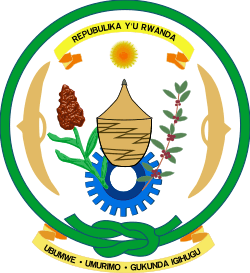1954 Rwandan parliamentary election
Indirect parliamentary elections were held in Rwanda in 1954.
 |
|---|
| This article is part of a series on the politics and government of Rwanda |
|
Government |
|
|
Judiciary |
|
|
United Nations in Rwanda |
Electoral system
The Decree of 14 July 1952 by the Belgian authorities introduced an element of democracy to the Rwandan political system. A complicated electoral system was created, which involved seven stages of elections to eventually elect the national Superior Council (French: Conseil Superieur du Pays).[1]
| Council | Elected members | Ex officio members | Other members |
|---|---|---|---|
| Sub-Chiefdom Council | 5–10 members elected by 10–18 notables | Sub-chiefs | |
| Chiefdom Council | 10–18 members, 5–9 elected by sub-chiefs and 5–9 elected by notables | Chiefs | |
| Territorial Council | Sub-chiefs elected from amongst their own and notables elected by Chiefdom Councils | Chiefs | |
| Superior Council | 6 chiefs elected from their own number, 9 notables elected by Territorial Councils | King, presidents of the Territorial Councils | Up to 8 co-opted |
Results
The elections in the sub-chiefdoms and chiefdoms were held in 1953, with the elections to the Territorial Councils and the Superior Council following in 1954.[2]
| Council | Members | Votes cast | ||||||||||
|---|---|---|---|---|---|---|---|---|---|---|---|---|
| Hutus | Tutsis | Total | Hutu | Tutsi | Twa | Total | ||||||
| Elected chiefs |
Elected notables |
Co-opted | Elected chiefs |
Elected notables |
Ex officio | Co-opted | ||||||
| Sub-chiefdom councils | 0 | 1,995 | 0 | 0 | 1,562 | 628 | 0 | 4,187 | 7,674 | 5,442 | 29 | 13,485 |
| Chiefdom councils | 1 | 78 | 0 | 299 | 268 | 46 | 0 | 692 | 79 | 613 | 0 | 692 |
| Territorial councils | 0 | 19 | 0 | 56 | 83 | 46 | 0 | 204 | 19 | 185 | 0 | 204 |
| Superior Council | 0 | 0 | 3 | 6 | 9 | 10 | 5 | 33 | 3 | 29 | 0 | 32 |
| Source: Sternberger et al. | ||||||||||||
References
- Dolf Sternberger, Bernhard Vogel, Dieter Nohlen & Klaus Landfried (1978) Die Wahl der Parlamente: Band II: Afrika, Zweiter Halbband, p1699
- Sternberger et al, p1725
This article is issued from Wikipedia. The text is licensed under Creative Commons - Attribution - Sharealike. Additional terms may apply for the media files.